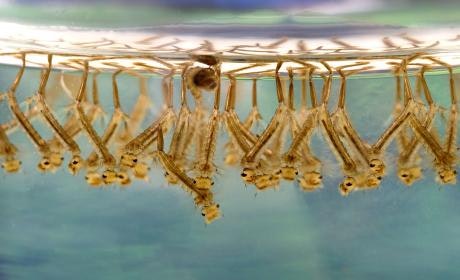Larval Mosquito Control

Products used for control of mosquito larvae
Products used to control mosquito larvae are called larvicides. The District mainly uses three different types of larvicide, plus one mosquito predator:
BVA-2 Oil: A refined petroleum distillate that breaks down in a few days. It is applied to the surface of standing water and causes mosquito larvae to drown.
Methoprene: A juvenile growth hormone that is specific to mosquito larvae. It mimics the growth hormone produced in a developing larva. They stop producing the hormone when they pupate. When methoprene is applied to the water, it keeps the larvae in a juvenile stage and does not allow them to complete their life cycle..
Bacillus thuringensis israelis (Bti): A bacteria that is toxic to mosquito larvae. The bacteria causes the stomach lining of mosquito larvae to rupture and ultimately kills the mosquito larvae. Learn more about Bti HERE.
Mosquito fish (Gambusia affinis): These fish are available at no additional charge to residents with backyard fishponds or stagnant swimming pools. These fish love to eat mosquito larvae and are a great biological control method.
Application of products used for control of mosquito larvae
Mosquito larvae are only found in standing water, so mosquito larval control products are applied to water. These products are often applied by hand to small areas, such as backyard ponds and catch basins.
The District uses a helicopter to apply solid granular larvicide to larger areas where there is dense vegetation or where applying the product on foot might harm sensitive wildlife and habitats. Currently, a helicopter is used at Annex Lake, Mills Field, and Sharp Park golf course.
Materials used by the District are regulated by California Department of Public Health in conjunction with County of San Mateo Agricultural Commissioner, and are only applied by licensed, trained personnel.
Page last reviewed: June 29, 2021

